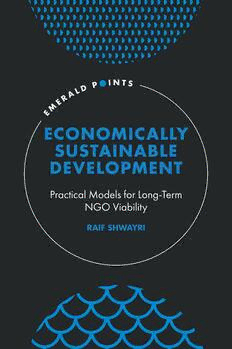Table Of ContentECONOMICALLY SUSTAINABLE
DEVELOPMENT
This page intentionally left blank
ECONOMICALLY SUSTAINABLE
DEVELOPMENT
Practical Models for
Long-Term NGO Viability
BY
RAIF SHWAYRI
United Kingdom – North America – Japan – India
Malaysia – China
EmeraldPublishingLimited
HowardHouse,WagonLane,BingleyBD161WA,UK
Firstedition2021
Copyright©2021EmeraldPublishingLimited
Reprintsandpermissionsservice
Contact:[email protected]
Nopartofthisbookmaybereproduced,storedinaretrievalsystem,transmittedin
anyformorbyanymeanselectronic,mechanical,photocopying,recordingor
otherwisewithouteitherthepriorwrittenpermissionofthepublisheroralicence
permittingrestrictedcopyingissuedintheUKbyTheCopyrightLicensingAgency
andintheUSAbyTheCopyrightClearanceCenter.Anyopinionsexpressedin
thechaptersarethoseoftheauthors.WhilstEmeraldmakeseveryefforttoensure
thequalityandaccuracyofitscontent,Emeraldmakesnorepresentationimpliedor
otherwise,astothechapters’suitabilityandapplicationanddisclaimsanywarranties,express
orimplied,totheiruse.
BritishLibraryCataloguinginPublicationData
AcataloguerecordforthisbookisavailablefromtheBritishLibrary
ISBN:978-1-80043-775-3(Print)
ISBN:978-1-80043-774-6(Online)
ISBN:978-1-80043-776-0(Epub)
CONTENTS
Foreword: From Aid to Development vii
Acknowledgment xi
Introduction: Breaking Away from a Trickle-down Attitude 1
1. Rely on the Locals 5
1. Question Your Incentives. Appreciate Complexities and Traditions 5
2. Make Sense of Industrial Relations 11
2. Think Sustainability First 15
1. Economic Viability: Determine a Critical Size 17
2. Business Modeling 19
3. Build an Integrated Plan of Action 23
1. School–Enterprise Model 24
2. Galbraith Chain: Integration of Cycles and of Communities 25
3. Internal Leveraging to Serve a Common Cause 27
4. Support Higher Education and Applied Research 31
1. Nurture Local Institutions to Train the Leaders of Tomorrow 32
2. Trigger a Research-Oriented Mindset Throughout 35
5. Understand the Need to Structure 39
1. Subsidiarity and Expediency 39
2. System versus Structure 41
3. Plan Your Exit and Transfer Strategies 43
6. Choose Your Assessment Tool: M&E or ROI? 45
1. Failures of Institutional Monitoring & Evaluation Tools 45
2. The Importance of Private Investors 47
3. Social Equity 49
7. The Acid Test 51
1. It Takes These Two to Tango: FDI and Exports 55
2. Use Aid Budgets to Activate Sustainable Development 56
v
vi Contents
8. Learn to Rejuvenate 59
1. Diversify Your Programs and Operations 59
2. Kill Your Overheads: Yield and Contribution Management 60
Conclusion: Loudison 63
Further Reading 67
Journals 67
French 67
Web Journals 67
Bibliography 69
Index 75
FOREWORD: FROM AID TO
DEVELOPMENT
IhaveknownRaifShwayriformanyyears.Wemetin1994inBrusselswhen
hecametomewithhisideasforadevelopmentproject.Wewerethesameage,
had recently taken charge of senior positions at our respective organizations,
hisinLebanon,mineinBelgium,andourpathswouldthereaftercoincide.So
muchso,thatIdidn’treallyneedtoreadthemanuscriptforthisbookinorder
to write the preface; however few the following pages, they have taken 26
yearstocompileifonetakestheirrealmeasure:thetimeithastakentobring
the ideas they convey to fruition, to implementation, to revision, and reen-
actment. And all along, I was there, a sturdy brother-in-arms, debating,
arguing sometimes, and sharing in the joy of conceiving new models and
giving them wings to fly.
In26years,weimplementedtogethersometwodozenprogramsthatserve
a large population today, programs that have the particularity of being sus-
tainableonallfronts.ForsustainabilityhasalwaysbeenRaif’sworry.Moreto
the point, Raif has constantly lived his programs with the anxiety of an
entrepreneur who fears what tomorrow brings, anticipating the future before
undertaking the present. In doing so, he has set a precedent in our world of
development,ofaccountingforresultsbeyondthescopeofawrittenproposal.
Viability of any program is at the heart of all his endeavors, and numerous
were the times when we turned away a funded project that did not hold the
aptitude to stand alone after implementation.
But sustainability was not his only tool for development. Raif could not
foresee any initiative that was not beholden by the locals themselves. His
unique experience at standing on both sides of the fence gave him a precious
andperceptiveoutlookondevelopment.Aninitiative,hesays,cannotsurvive
unless it is conceived and appropriated by the people themselves, not devised
for them by international organizations, however decent or ambitious their
intentions are. In our long years together, I often heard him argue that “you
vii
viii Foreword:FromAidtoDevelopment
can send aid, but development is brewed locally,” a statement he repeated in
his introduction for this book.
When you take these two concerns of Raif, sustainability and local
appropriationof initiatives, and you put them ina shaker,the result is called
lasting development. For what is development if not the advancement of the
socialandeconomicconditionsofacommunity,donebythelocalsthemselves,
and inscribed in a perennial evolution, in respect of traditions, cultures,
gender, inclusion principles, and human dignity? Take these two ingredients
andthrivewiththem,andyouhavetheassuranceofdepartingfromtheshort-
sighted, selective and detrimental aid to harbor righteous and all-embracing
development. It takes this shaker to get from aid to development.
Raif is not only a social entrepreneur but also an alert academic. Having
identified his ingredients for development early in his career, he went seeking
tosystemizehisfindingsinmodelsthatcanbeunderstood,valued,andshared.
I know this because we worked on these models together. The School–
Enterprise model is a fine paradigm that was met with tremendous success,
some of which is related in the following pages. An Education for the Real
Worldisanother,sopoignantthatitbecamethefoundationalstatementofthe
university that Raif initiated, a nonprofit institution that embodies the values
of real development—a mover and shaker in its own right. And because
microentrepreneurs have been at the heart of our development initiatives, it
was natural that our crowning achievement spoke to them and became the
cornerstone of all our endeavors. The Micro-MBA, a provocative model,
disruptive of standardized thinking and one of the “think-out-of-the-box”
models that Raif refers to in this book, is the new paradigm that ACTEC is
pursuing at this point, recording outstanding results in certain parts of the
world already.
Perhaps the successful enterprises that Raif has conducted stem also from
the fact that he has acted on them in the spirit of giving. Not the typical
philanthropy or aid-governed charity, but the real sense of giving “as a con-
dition of being,” to quote his own words. When the mission is pure, to be
found outside of one’s own persona, the anxiety of the entrepreneur takes a
differentproportion.Thepurertheincentiveandthemoredetached,themore
elevated the discourse and the objective. And the more anxious the social
entrepreneur!Thereisnodoubtthatourfriendshiphasgrownovertheyears
onthefootpathsofdevelopmentandinitstrenches,andithasshonewiththe
smilesofthousandsofyoungpeoplewhogrewandnurturedwiththeseedswe
havesown.Itremains,however,thattheinitialsparkthatbroughtustogether
in the beginning was there, in the art of giving as a condition of being. The
Foreword: From Aidto Development ix
story that Raif delivers in the conclusion speaks of that, of the basic and
uncomplicated impulse that defines the true wisdom of development.
Ihaveseenthisbook’sstoryinaction,andItestifytoitsveracity.Iwould
say humbly that somewhere in between the lines, I hear echoes of my own
whispers. I say this with the intellectual integrity of someone who has picked
thesamefight,thatofworldjustice,reasonedandinformed,andwiththesame
compelling love of humanity.
Fromaidtodevelopment:withwit,style,andfirmness,RaifShwayrishows
us in this book how to cross the ravine.
Daniel Turiel
CEO of Association of Cultural, Technical and Educational Cooperation
(ACTEC), Brussels

